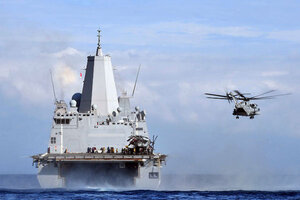Pentagon moves USS Mesa Verde nearer Iraq. What can it do?
The USS comes with quick-reaction forces and MV-22 Ospreys, which come in handy because they can take off and land vertically. It's a sign of how dire the situation is becoming.

A CH-53 Sea Stallion helicopter launches from the USS Mesa Verde during preparations for a 2011 exercise in the Mediterranean Sea. The ship entered the Persian Gulf on Monday to support possible US action in Iraq.
Mass Communication Specialist 2nd Class Josue L. Escobosa/USNavy/Reuters/File
Washington
With Islamist militants bearing down on Baghdad, Defense Secretary Chuck Hagel ordered yet another ship to the Persian Gulf Monday. The USS Mesa Verde will join a US aircraft carrier strike group and give President Obama “additional options to protect American citizens and interests in Iraq, should he chose to use them,” Pentagon Press Secretary Rear Adm. John Kirby said Monday.
The Pentagon is also providing some 50 to 100 US troops to help with security at US diplomatic facilities in Baghdad, which could include the temporary relocation of some embassy personnel in the face of possible attacks by the Islamic State of Iraq and Syria (ISIS).
The USS Mesa Verde comes with quick-reaction forces and a complement of MV-22 Ospreys, which come in particularly handy during, say, evacuation operations because of their ability to land and takeoff vertically, like a helicopter.
Pentagon officials, however, sought to play down the image of airlift evacuations for embassy personnel, with its echoes of the Vietnam War.
Ospreys “can do a lot of things,” Rear Admiral Kirby said. “Evacuation would be to read way too far into that.”
But there is no doubt that the situation on the ground in Iraq is dire, with reports that ISIS is engaged in mass executions of Iraqi security forces, who rather than fighting are often shedding their uniforms and fleeing when they can.
Pentagon officials say that they do not yet have independent confirmation of ISIS massacres, but that ISIS is a “very dangerous organization,” Kirby said Monday. “That they are violent should be self-evident to everybody.”
Lawmakers have raised the possibility of US airstrikes in response to ISIS advances. After years of war, Al Qaeda and many Taliban fighters heave learned not to mass in one place for fear of providing US forces with easy targets, but ISIS fighters do not seem to share this approach. Some defense officials say that could make B-1 bomber strikes a possibility.
There are also Reaper drones stationed at bases throughout the region. Defense officials said last week that the US has stepped up surveillance flights over Iraq with unarmed drones. Pentagon officials would not say Monday whether the decision has been made to arm those drones or not.
There is some concern that US-made shoulder-fired stinger missiles may have fallen into the hands of ISIS fighters, as well. Pentagon officials could not confirm those reports. Curiously, they also couldn't confirm whether the US had provided stinger missiles to Iraq. ISIS has reportedly seized Humvees and other US-made equipment from Iraqi security forces.
For now, the Pentagon is weighing “near-term options” for Mr. Obama “to try to help [Iraqi security forces] break this momentum” of advancing ISIS fighters.
Pentagon officials say that they are working with the Iraqi military through official channels as well, namely the Office of Security Cooperation out of the US embassy in Baghdad, which has directed foreign sales of US military equipment to Iraq since the end of the war in 2011. Some former US commanders in Iraq are even receiving unofficial calls from former Iraqi counterparts, asking for advice.
Communication between the American and Iraqi militaries “remains very open,” Kirby said, “and very active.”

